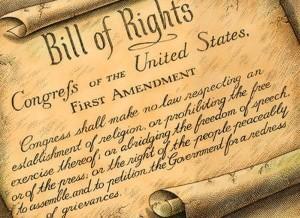 With all the recent talk about states enacting versions of the national Religious Freedom Restoration Act, I’ve been wondering: What exactly prompted the need for national and state bills in the first place? Why did legislators conclude that religious freedom had to be restored, and when did they think it disappeared?
With all the recent talk about states enacting versions of the national Religious Freedom Restoration Act, I’ve been wondering: What exactly prompted the need for national and state bills in the first place? Why did legislators conclude that religious freedom had to be restored, and when did they think it disappeared?
The national law was passed in 1993. It was sponsored by two Democratic senators, Ted Kennedy and Chuck Schumer, and signed into law by President Clinton. The House was unanimous in approving it. All but three senators voted in favor. It had the support of the Religious Action Center of Reform Judaism, the National Association of Evangelicals, and the American Civil Liberties Union. Which is to say, stalwarts of the left and the right came together for this legislation.
The law clarifies some issues having to do with the interaction between government and religion. The Constitution, of course, states that “Congress shall make no law respecting the establishment of religion or prohibiting the free exercise thereof.” The RFRA recognized that a religiously neutral law can sometimes burden a religion just as much as a law intended to interfere with a religion. So, RFRA says the government “shall not substantially burden a person’s exercise of religion even if the burden results from a rule of general applicability.” There is an exception if two conditions are met:
- The burden must be necessary for the furtherance of a compelling government interest.
- The law must be the least restrictive way to further the government interest.
The law applies to all religions, but in practice, it generally has applied to native American religions and issues revolving around expansion of government projects onto sacred land and the use of peyote by these religions. RFRA strengthened religious rights in these areas.
In 1997, part of the law was overturned. The San Antonio archdiocese of the Catholic Church wanted to tear down a church in Boerne, Texas, but was prohibited from doing so by the town, which protected the building as a historic landmark. The church fought, citing the national RFRA, but the Supreme Court ruled that the national law was valid at the federal level but not applicable to states. Today, the church built in 1923 stands, but there is a modern worship structure behind it. (Congress acted subsequently to give special privileges to religious land owners.)
Some state legislators took this as a reason to pass state versions of RFRA laws. They largely lay dormant, however, until the Supreme Court’s Hobby Lobby ruling last year.
The court allowed religiously held companies to argue under RFRA, when the law only talks about the religious rights of people. Some have argued that companies, even those run by religious families, don’t have religious rights in the way that individuals do, and so RFRA shouldn’t apply.
The court, in Hobby Lobby, also seemed to have a loose definition of RFRA’s requirement that religious objectors prove the offending law imposes a “substantial burden” on their religious practices. The Affordable Care Act did not ask companies to hand out or promote contraceptives, just to pay for employee health insurance plans that offered them. Justice Ginsburg, in her dissent, argued this connection was “too attenuated to rank as substantial.”
States courts are free to interpret state RFRAs as they like. The Hobby Lobby decision, however, demonstrated how RFRA laws can be used to take a bite out of legislation as far-reaching as the Affordable Care Act.
Since 2013, five more states have enacted RFRA legislation: Kentucky, Kansas, Mississippi and, this year, Indiana and Arkansas. Only Indiana’s version includes civil rights protections, and those were added only after a blitz of national protest.
So the answer to the question I posed earlier is this: Our religious freedoms were never taken away, and they didn’t need to be “restored.” Well-meaning legislators were trying to expand the definition and scope of religious freedom, but they opened a can of worms they never anticipated. The Supreme Court exacerbated the problem, I think, by ignoring one of the key principles they espouse, which is understanding and honoring the original intent of the law.
We’ll just have to see where the present trends will lead. I fully understand that a religious organization can’t and shouldn’t be forced to take members or to engage in practices it doesn’t support.
I don’t understand how a business owner could say his religion teaches that black people (or any specific race or group) are inferior or evil and legally get away with not serving them. Is it possible? Most of my life, I would have said no. Now I’m not so sure.
Such a business owner can believe anything he wants, I think, but he has no right to act on his beliefs in a way that denies service based on them.
Your thoughts?

